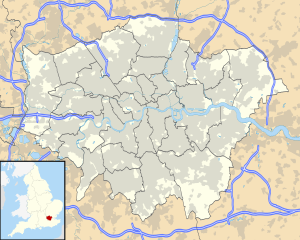Blackwall tunnel
| Blackwall tunnel | ||
|---|---|---|
|
South tunnel entrance
|
||
| use | Road traffic | |
| traffic connection | A102 | |
| place | London | |
| length | West tube: 1362 m East tube: 1201 m |
|
| Number of tubes | 2 | |
| construction | ||
| building-costs | W: £ 1,400,000 O: £ 9,000,000 |
|
| start of building | W: 1891 O: 1960 |
|
| completion | W: 1897 O: 1967 |
|
| planner | W: Alexander Binnie & Joseph Bazalgette O: Terry Farrell |
|
| business | ||
| operator | W: Metropolitan Board of Works later: London County Council O: London County Council |
|
| release | W: May 22, 1897 O: August 2, 1967 |
|
| location | ||
|
|
||
| Coordinates | ||
| West tube north portal | 51 ° 30 ′ 33 " N , 0 ° 0 ′ 26" W. | |
| Eastern tunnel north portal | 51 ° 30 ′ 33 " N , 0 ° 0 ′ 24" W. | |
| West tube south portal | 51 ° 29 ′ 56 ″ N , 0 ° 0 ′ 5 ″ E | |
| Eastern tube south portal | 51 ° 30 ′ 2 ″ N , 0 ° 0 ′ 7 ″ E | |
The Blackwall Tunnel is a road tunnel under the River Thames in London . It connects the London Borough of Tower Hamlets on the north side with the Royal Borough of Greenwich on the south side and consists of two individual tunnels that were opened in 1897 and 1967 respectively. The southern tunnel portal is right next to the Millennium Dome . The tunnel connects the two highways A2 and A12 and was the easternmost river crossing for vehicles (with the exception of ferries) until the opening of the Dartford Tunnel in 1963.
history
The older western tunnel tube was designed by Alexander Binnie and built from 1892 by the company S. Pearson & Sons . It was originally commissioned by the Metropolitan Board of Works , but responsibility passed to London County Council , which replaced the former in 1889. The construction costs amounted to 1.4 million pounds , during the construction of seven people were killed. The official opening took place on May 22, 1897 by the Prince of Wales , later King Edward VII.
At 1344 meters, the Blackwall Tunnel was the longest underwater tunnel in the world at the time. It was built using shield tunneling and air pressure methods. James Henry Greathead , the pioneer of shield tunneling , acted as advisor. Also involved in the planning was Joseph Bazalgette , chief engineer of the London sewer system. To make way for the construction site in Greenwich, 600 people had to be relocated. One of the demolished houses is believed to have been owned by Sir Walter Raleigh .
Today the western tunnel tube is only driven in a northerly direction, it is also not approved for vehicles with a height of over four meters. The south portal is made of red bricks. The two-lane tunnel has some tight curves, although there are several explanations for this: The curves are said to have been built so that the horses would not go through as soon as they saw the light of day (in 1897 motor vehicles were still extremely rare). Another theory is that an old plague cemetery was bypassed.
The eastern tunnel was opened on August 2, 1967 and is much better adapted to the requirements of modern road traffic. It is significantly wider, can be driven on by vehicles up to 4.72 meters high and has no tight curves. The distinctive ventilation shafts were designed in 1961–62 by Terry Farrell , who was then an architect for London County Council . The northern pair is in Blackwall, while the southern pair is now integrated into the Millennium Dome. The shaft towers have been a listed building since 2000.
Drive through the old western tunnel
Drive through the eastern tunnel
Individual evidence
- ^ Section of the Blackwall tunnel. Royal Museums of Greenwich. Accessed May 23, 2017 (resettlement)
- ↑ Gordon J. Lynch, Diane Canwell, Jonathan Sutherland: Famous Ghosts and Haunted Places. The Rosen Publishing Group. 2011 pp. 35–36. ISBN 978-1-4488-5985-6 .
Web links
|
Upstream Greenwich Pedestrian Tunnel Docklands Light Railway Tunnel Jubilee Line Tunnel |
River crossings of the Thames |
Jubilee Line Emirates Air Line downstream tunnel |




